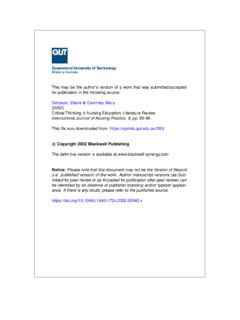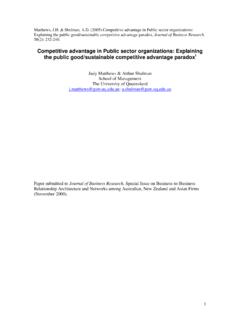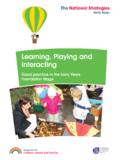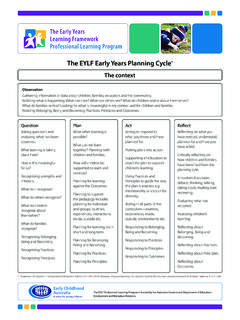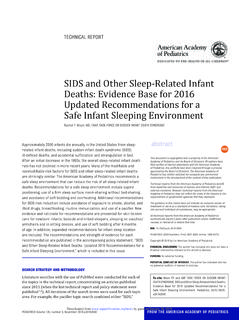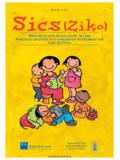Transcription of Educating for sustainability in the early years: Creating ...
1 Davis, Julie M. (2005) Educating for sustainability in the early years: Creating cultural change in a child care setting. Australian Journal of Environmental Education 21:pp. 47- 55. Educating for sustainability in the early years: Creating cultural change in a child care setting Dr Julie Davis Centre for Learning Innovation, Queensland University of Technology, Brisbane, Australia. Email: Bionote Dr Julie Davis is a researcher in the Centre for Learning Innovation, and lecturer in the School of early Childhood, at the Queensland University of Technology. Abstract The early childhood education field has been slow to take up the challenge of sustainability .
2 However, Brisbane's Campus Kindergarten is one early education centre that is making serious efforts in this regard. In 1997, Campus Kindergarten initiated its Sustainable Planet Project involving a variety of curriculum and pedagogical activities that have led to enhanced play spaces, reduced waste, lowered water consumption and improved biodiversity. Such changes are not curriculum add-ons', however. A study of curriculum decision-making processes shows that a culture of sustainability permeates the centre. This has been by a process of slowly evolving changes that have led to a reculturation of many social and environmental practices.
3 This study also shows that very young children, in the presence of passionate and committed teachers, are quite capable of engaging in education for sustainability and in making a difference'. Keywords: early childhood, collaboration, educational change , empowerment, leadership, professional development, sustainability 1. Introduction There are very few early education centres, in Australia and internationally, that demonstrate exemplary environmental education practice and only a small number of research publications that actually focus on early childhood education for sustainability (Davis & Elliott, 2003; New South Wales Environmental Protection Agency, 2003).
4 Consequently, there is also a lack of indepth studies of how an early childhood service - catering for children in the years before school - might actually go about incorporating sustainability into their day-to-day curriculum practices. This paper, based on a study undertaken in a long day care centre in Brisbane, Australia, seeks to fill this gap. The research involved two university researchers who, with an eight- year professional relationship with the centre, undertook a focussed study in 2004. This utilised ethnographic inquiry to explicate the initial triggers for environmental education; how the curriculum has changed over time; how environmental issues/ topics are raised and acted upon; and how sustainability thinking and practices have been integrated into the cultural practices of the centre.
5 To explore these topics, the following research techniques were utilised: participant observation; indepth interviews and email conversations with key participants; focus group discussions with staff and with parents; a parent survey; and the collection of documents such as prospectuses, newsletters, planning guides, photographs and project notes. This latter also included the collection and analysis of curriculum documentation developed jointly by the children and teachers, including records of dialogue, photographs, drawings, stories and curriculum webs. The study was conducted with' and for' participants rather than on' participants (Heron & Reason, 2001).
6 Hence, data collection, analysis, and reporting employed processes designed to build relationships and dialogue within and between researchers, participants and the wider community. This partnership approach with and between the stakeholders was highly valued by both the researchers and the Campus Kindergarten community. The research setting Campus Kindergarten is an early education centre serving a culturally diverse, well educated community, situated on the St Lucia campus of the University of Queensland in Brisbane. Opening hours are from am till pm, Mondays to Fridays. The centre 2. caters for children aged two and a half years to around six years, from a wide range of language and cultural backgrounds.
7 Each day around sixty-three children, many attending part time, are catered for, with seventy-nine children across three age groups attending weekly. There are nineteen staff members of whom six are full time. Thus the organization of both the staff and children's arrangements is quite complex. The centre has an educational philosophy that is child-centred, holistic and futures- oriented, where rights, respect and trust permeate the culture and curriculum (Prospectus 2004, p. 1). This means that the teachers seek to interweave into everyday practices, their care and concern for children along with concern and respect for the centre's natural and built environments.
8 These qualities underpin all facets of Campus Kindergarten's organisation and culture, including the centre's Sustainable Planet Project. The Sustainable Planet Project Origins This project, a whole of centre' initiative, had its origins in 1997, the outcome of a facilitated team-building exercise. At the time, the teachers were seeking a shared project that would also create greater complementarity between their personal and working lives. As a past staff member commented, I felt that I wasn't putting enough of my own personality into the room. It was great to give toward the children but there was none of me in there.
9 The team-building process revealed a common interest amongst the staff - the environment. Consequently, under the banner of the Sustainable Planet Project, individual staff members were able to add value' to their work as early childhood educators by including personal interests such as gardening, wildlife conservation and recycling into their day-to-day work at the centre. From the start, the project had an action-oriented focus, encapsulated in the sub-title of the project Saving our planet: become a conscious part of the solution . First steps Once the idea of the Sustainable Planet Project was formulated, the teachers began working with the children on numerous small-scale, mini-projects allied with their own particular environmental interests.
10 These included: 3. Figure 1: Initial mini-projects in the Sustainable Planet Project (Campus Kindergarten teachers, 1997). While all these mini-projects still continue, initially the Sustainable Planet Project had its operational challenges. A key barrier was the variable levels of knowledge and experience regarding environmental matters amongst the staff leading to periods of great activity and times when interest and energy waned. There were times when other priorities and projects demanded time, energy and resources. There have also been frustrations with the level of parental commitment to some initiatives, especially the litterless' lunch' policy which requires parents to pack the children's lunches brought daily from home in ways that minimise pre-packaged food.







